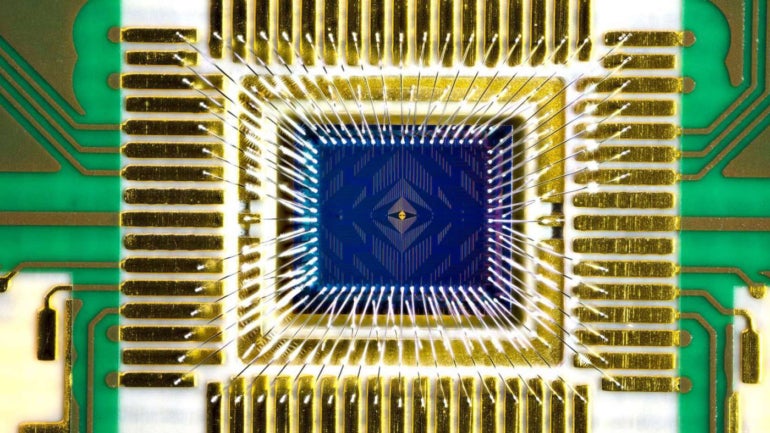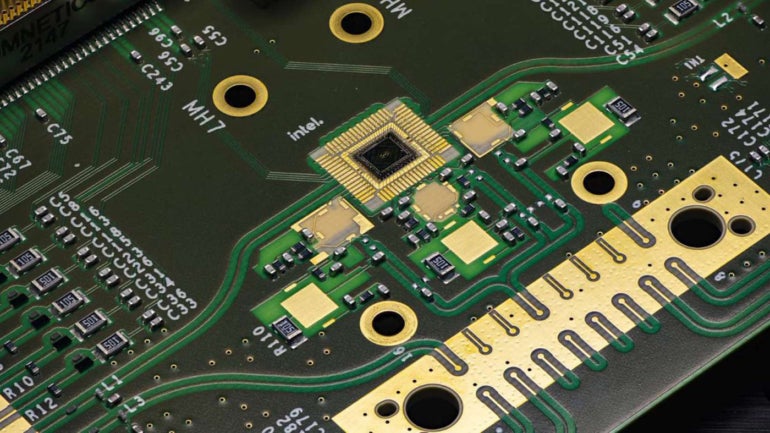
Will quantum computing ever be practical? Maybe. Intel thinks it has a solution with the Tunnel Falls quantum research chip, which has grown out of the company’s plan for manufacturing quantum chips using relatively conventional silicon. Intel is testing the Tunnel Falls chip at universities and national laboratories across the U.S.
We spoke to two employees at Intel Labs – Anne Matsuura, director of quantum and molecular technologies, and Ravi Pillarisetty, senior device engineer – about what they’ve learned since the quantum test chips were made available on June 15. Matsuura is an expert on Intel’s Quantum Software Development Kit, which gives developers a simulated quantum computing environment in which to learn how to write code for quantum hardware. This interview was edited for length and clarity.
Jump to:
Megan Crouse: The Tunnel Falls chip is being used in pilot programs at University of Maryland’s Laboratory for Physical Sciences, Sandia National Laboratories, the University of Rochester and the University of Wisconsin-Madison through the U.S. Army Research Office’s Qubits for Computing Foundry program, which was announced in June 2023. What has been learned?
Ravi Pillarisetty: We were working internally on our 12-qubit Tunnel Falls chip (Figure A) for quite a while. When you look at the academic community, it’s very difficult to make these devices, so oftentimes you have one PhD student who has one device that’s passed down among different generations of students.
Figure A
So what we’ve done here at Intel is by actually fabricating these chips, we’re able to give them out to different university or institutional partners. For example, Maryland through LPS, Rochester, Wisconsin and Sandia National Laboratories.
There are two classes of things done there that complement our internal work. One thing that we look at is: How do we improve the device? Fundamentally, in a qubit, at the individual one- or two- qubit level, there are error rates that come from inherent noise in the system. So how do we find out the root cause of that noise? And how do we improve our process or work with our vendors to actually create new kinds of materials, learn how to improve the interface physics or build better substrates?
The other aspect that we look at is how we can actually operate our qubits better. There are different approaches. For example, with 12 quantum dots, we can operate them as spin qubits where each dot is an individual qubit, or we can do some composite encoding where two or three dots form a qubit.
There are trade-offs. Different encodings might be a lot easier to scale and build within our manufacturing infrastructure, but there might be trade-offs in terms of error rates that we need to holistically evaluate as we make a decision about what is the best encoding type.
This work complements our program and also helps us develop the future things we need. We’re able to actually give our Tunnel Falls chip out, and research is being done on our exact spin qubit process. And so the learning is much more amplified in this case because it’s directly feeding into our actual chip and our actual process.
Megan Crouse: What real-world problems might quantum computing solve, and how do you think it will affect enterprise business tools?
Anne Matsuura: A quantum computer will be an accelerator. It will be used alongside a high-powered computing center, or it will be used alongside classical compute.
First of all, we will be selling a lot more CPUs as quantum progresses. Quantum will help to accelerate the sale of classical processing units as well.
A lot of the application areas are simulating natural systems, fluid dynamics and simulation of materials.
My background is originally in high-temperature superconductivity, understanding how you create a superconductor with a higher and higher critical temperature so that maybe, eventually, you have resistance-less superconducting power lines at room temperature or other pie-in-the-sky ideas that were being discussed decades ago.
The problem was some simulation was intractable for a classical computer – it still is. Maybe with a really large-scale quantum computer with millions of qubits, maybe you will start to be able to understand how to simulate materials that have magnetic and electronic properties that you really want (for next-generation applications).
Those kinds of things can come to fruition with quantum computing eventually in a commercial-size machine with error correction.
SEE: Quantum computing could be used for the valuation of financial products and the assessment of credit risks. (TechRepublic)
Megan Crouse: One of Intel’s core strengths is chip manufacturing; how did you leverage that strength in this cutting-edge industry of quantum hardware to create the Tunnel Falls chip?
Ravi Pillarisetty: When you look at the landscape of quantum computing and our competitors, there are a lot of different types of qubit technologies that are out there, such as superconducting ion traps and photonic qubits, but there are quantum dot-based qubits that are based on semiconductors and based on silicon. And they’re the only qubit technology that is truly compatible with the standard CMOS (complementary metal-oxide-semiconductor) manufacturing platform. (Figure B)
Figure B

So at Intel, our vision here is to actually build qubits that look very much like transistors and to leverage our rich history and the last 50 years of Moore’s Law innovations. We’ve been able to go from the first microprocessor, which had a few thousand transistors on it, to something today that has hundreds of billions of transistors on it, leveraging all of our rich history to do that scaling. At the end of the day, we believe to do anything that’s going to be of commercial value and importance in this field, you’re going to require millions of qubits.
Megan Crouse: Intel Director of Quantum Hardware Jim Clark said in June the company’s long-term strategy is to build a full-stack commercial quantum computing system. How long is long term, and where is Intel in terms of what you think your quantum work will look like in the next few years?
Ravi Pillarisetty: Typically, if you look through the history of transistors or other process technology, it takes about 10 years from the time it was brought into being researched at Intel to when it was put into product. That’s a similar timeline for many of the kinds of disruptive process technologies we have. It’s at least that far out for something as revolutionary as quantum computing. There has to be a lot of time invested into R&D.
We think about scaling holistically. For us, it’s about how do we get to a million qubits? Everything we’re doing here in terms of learning from Tunnel Falls, we basically applied that into a next-generation test chip that we’re taping out now.
Anne Matsuura: As far as the full stack, today you can use the Intel Quantum Software Development Kit, which is a full quantum computer in simulation. One thing that you can start doing today is trying to develop quantum algorithms and quantum applications. You can start to try to understand what you will use that large-scale quantum computer for.
That’s why we have the Intel Quantum SDK available today through the Intel Developer Cloud. It’s free to use. The Intel Quantum SDK is a scalable compiler and runtime, along with the simulation of the Intel quantum hardware. And so it’s both to get people thinking about: What are the useful quantum applications of the future? But also to get a community of users who are accustomed to and like to use Intel quantum technologies. It will be the same experience using the Quantum SDK as it will in the future using the quantum computer.
Megan Crouse: To me, it seems like the Quantum SDK is essentially training developers to work on these projects and figure out which use cases are good for them. So what have you learned so far from feedback on or work performed with the Quantum SDK since it came out?
Anne Matsuura: There’s another reason for the Intel Quantum SDK which might be a little different from other companies. We have been using it internally to run workloads full stack through a simulated quantum computer. So we start to understand whether we can give some advice to the qubit chip team and vice versa.
What does that tell us about the system architecture and what functionalities the qubit hardware has to be able to provide in order to run these kinds of quantum applications and algorithms?
What we’re learning about application areas is people are starting to use the Quantum SDK for, not surprisingly, simulating other quantum systems. We have a number of users who are interested in CFD – computational fluid dynamics – as well as things like computational chemistry, simulation of materials or solving linear systems of equations.
Megan Crouse: There are challenges when it comes to software programmability in quantum computing. What are those, and how might someone overcome them?
Anne Matsuura: What we’ve done with the Intel Quantum SDK is we’ve been trying to make it something that is more familiar looking to classical developers. Almost all of the quantum software tool chains so far are really focused on quantum physicists. So we’ve written in C++. We use the same kinds of structures that you do in C++. You see for loops and a modular structure that’s easier to debug.
But at the end of the day, you’re absolutely right: Quantum computing is still very much in the research stage. We need to do more research into programming languages that completely abstract away the quantum hardware so that a user doesn’t have to know the quantum operations that are available. This is something that we are doing research in, as are others. It’s something that needs to happen in order for quantum computing to become more easily programmable.